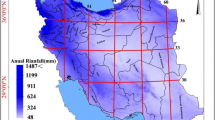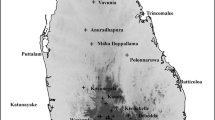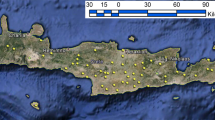Abstract
Analysis of rainfall data from the island of Crete, Greece was performed to identify key hydrological years and return periods as well as to analyze the inter-annual behavior of the rainfall variability during the period 1981–2014. The rainfall spatial distribution was also examined in detail to identify vulnerable areas of the island. Data analysis using statistical tools and spectral analysis were applied to investigate and interpret the temporal course of the available rainfall data set. In addition, spatial analysis techniques were applied and compared to determine the rainfall spatial distribution on the island of Crete. The analysis presented that in contrast to Regional Climate Model estimations, rainfall rates have not decreased, while return periods vary depending on seasonality and geographic location. A small but statistical significant increasing trend was detected in the inter-annual rainfall variations as well as a significant rainfall cycle almost every 8 years. In addition, statistically significant correlation of the island’s rainfall variability with the North Atlantic Oscillation is identified for the examined period. On the other hand, regression kriging method combining surface elevation as secondary information improved the estimation of the annual rainfall spatial variability on the island of Crete by 70% compared to ordinary kriging. The rainfall spatial and temporal trends on the island of Crete have variable characteristics that depend on the geographical area and on the hydrological period.

Maps were created using ArcGIS 10.2 (ESRI 2014) (http://www.esri.com/software/arcgis/arcgis-for-desktop)

Map was created using ArcGIS 10.2 (ESRI 2014) (http://www.esri.com/software/arcgis/arcgis-for-desktop)



The figure was created using a Matlab® (2010) environment (https://www.mathworks.com/)


Figure was created using the Matlab® (2010) environment (https://www.mathworks.com/)

Maps were created using ArcGIS 10.2 (ESRI 2014) (http://www.esri.com/software/arcgis/arcgis-for-desktop)

Map was created using ArcGIS 10.2 (ESRI 2014) (http://www.esri.com/software/arcgis/arcgis-for-desktop)
Similar content being viewed by others
References
Bierkens MFP, Knotters M, Hoogland T (2001) Space-time modeling of water table depth using a regionalized time series model and the Kalman filter. Water Resour Res 37:1277–1290
Brandimarte L, Di Baldassarre G, Bruni G, D’Odorico P, Montanari A (2011) Relation between the North-Atlantic Oscillation and hydroclimatic conditions in Mediterranean areas. Water Resour Manag 25:1269–1279. https://doi.org/10.1007/s11269-010-9742-5
Corona R, Montaldo N, Albertson JD (2018) On the role of NAO-driven interannual variability in rainfall seasonality on water resources and hydrologic design in a typical Mediterranean basin. J Hydrometeorol 19:485–498
Cressie N (1993) Statistics for spatial data (revised ed.). Wiley, New York
Deidda R et al (2013) Regional climate models’ performance in representing precipitation and temperature over selected Mediterranean areas. Hydrol Earth Syst Sci 17:5041–5059. https://doi.org/10.5194/hess-17-5041-2013
Delworth TL, Zeng F, Vecchi GA, Yang X, Zhang L, Zhang R (2016) The North Atlantic Oscillation as a driver of rapid climate change in the Northern Hemisphere. Nat Geosci 9:509–512. https://doi.org/10.1038/ngeo2738
Deutsch CV, Journel AG (1992) GSLIB. Geostatistical software library and user’s guide. Oxford University Press, New York
Drake JB (2014) Climate modeling for scientists and engineers. SIAM, Philadelphia
Eshel G, Farrell BF (2000) Mechanisms of eastern Mediterranean rainfall variability. J Atmos Sci 57:3219–3232
ESRI (2014) ESRI, ArcGIS release 10.2.2. Environmental Systems Research Institute, Redlands
Fernández-González S, del Río S, Castro A, Penas A, Fernández-Raga M, Calvo AI, Fraile R (2012) Connection between NAO, weather types and precipitation in León, Spain (1948–2008). Int J Climatol 32:2181–2196. https://doi.org/10.1002/joc.2431
Ferrari E, Caloiero T, Coscarelli R (2013) Influence of the North Atlantic Oscillation on winter rainfall in Calabria (southern Italy). Theor Appl Climatol 114:479–494. https://doi.org/10.1007/s00704-013-0856-6
Giorgi F, Lionello P (2008) Climate change projections for the Mediterranean region. Glob Planet Change 63:90–104
Goovaerts P (1997) Geostatistics for natural resources evaluation. Oxford University Press, New York
Goovaerts P (1999) Geostatistics in soil science: state-of-the-art and perspectives. Geoderma 89:1–45
Grillakis MG, Tsanis IK, Koutroulis AG (2010) Application of the HBV hydrological model in a flash flood case in Slovenia. Nat Hazards Earth Syst Sci 10:2713–2725
Hastik R, Cammerer H (2012) Regression kriging for ArcGIS 10. Institute of Geography, University of Innsbruck
Hertig E, Jacobeit J (2014) Variability of weather regimes in the North Atlantic-European area: past and future. Atmos Sci Lett 15:314–320. https://doi.org/10.1002/asl2.505
Hurrell J, National Center for Atmospheric Research Staff (Eds) (2017) The Climate Data Guide: Hurrell North Atlantic Oscillation (NAO) Index (station-based), Retrieved from https://climatedataguide.ucar.edu/climate-data/hurrell-north-atlantic-oscillation-nao-index-station-based. Accessed 12 May 2017
Hurrell JW, Van Loon H (1997) Decadal variations in climate associated with the North Atlantic oscillation. Clim Change 36:301–326. https://doi.org/10.1023/a:1005314315270
Jacob D et al (2007) An inter-comparison of regional climate models for Europe: model performance in present-day climate. Clim Change 81:31–52. https://doi.org/10.1007/s10584-006-9213-4
Jing L et al (2017) Effects of hydrological regime on development of Carex wet meadows in East Dongting Lake, a Ramsar Wetland for wintering waterbirds. Sci Rep 7:41761. https://doi.org/10.1038/srep41761
Kalogeropoulos K, Chalkias C (2013) Modelling the impacts of climate change on surface runoff in small Mediterranean catchments: empirical evidence from Greece. Water Environ J 27:505–513
Kisi O, Ay M (2014) Comparison of Mann–Kendall and innovative trend method for water quality parameters of the Kizilirmak River, Turkey. J Hydrol 513:362–375. https://doi.org/10.1016/j.jhydrol.2014.03.005
Kitanidis PK (1997) Introduction to geostatistics. Cambridge University Press, Cambridge
Knotters M, Bierkens MFP (2000) Physical basis of time series models for water table depths. Water Resour Res 36:181–188. https://doi.org/10.1029/1999wr900288
Koutroulis AG, Tsanis IK, Daliakopoulos IN, Jacob D (2013) Impact of climate change on water resources status: a case study for Crete Island, Greece. J Hydrol 479:146–158. https://doi.org/10.1016/j.jhydrol.2012.11.055
Krichak SO, Alpert P (2005) Signatures of the NAO in the atmospheric circulation during wet winter months over the Mediterranean region. Theor Appl Climatol 82:27–39. https://doi.org/10.1007/s00704-004-0119-7
Leuangthong O, McLennan JA, Deutsch CV (2004) Minimum acceptance criteria for geostatistics realizations. Nat Resour Res 13:131–141
Lelieveld J, Hadjinicolaou P, Kostopoulou E, Chenoweth J, El Maayar M, Giannakopoulos C et al (2012) Climate change and impacts in the Eastern Mediterranean and the Middle East. Clim Change 114(3):667–687
Longobardi A, Villani P (2010) Trend analysis of annual and seasonal rainfall time series in the Mediterranean area. Int J Climatol 30:1538–1546. https://doi.org/10.1002/joc.2001
Maas GS, Macklin MG (2002) The impact of recent climate change on flooding and sediment supply within a Mediterranean mountain catchment, southwestern Crete, Greece. Earth Surf Proc Land 27:1087–1105. https://doi.org/10.1002/esp.398
Masih I, Uhlenbrook S, Maskey S, Ahmad MD (2010) Regionalization of a conceptual rainfall–runoff model based on similarity of the flow duration curve: a case study from the semi-arid Karkheh basin, Iran. J Hydrol 391:188–201. https://doi.org/10.1016/j.jhydrol.2010.07.018
MATLAB (2010) MATLAB, 7.10 (R2010a) edn. The MathWorks Inc., Natick
Musial JP, Verstraete MM, Gobron N (2011) Technical note: comparing the effectiveness of recent algorithms to fill and smooth incomplete and noisy time series. Atmos Chem Phys 11:7905–7923. https://doi.org/10.5194/acp-11-7905-2011
Naoum S, Tsanis IK (2003) Temporal and spatial variation of annual rainfall on the island of Crete, Greece. Hydrol Process 17:1899–1922. https://doi.org/10.1002/hyp.1217
Nastos PT, Politi N, Kapsomenakis J (2013) Spatial and temporal variability of the Aridity Index in Greece. Atmos Res 119:140–152
Rivest M, Marcotte D, Pasquier P (2008) Hydraulic head field estimation using kriging with an external drift: a way to consider conceptual model information. J Hydrol 361:349–361
Skøien JO, Blöschl G (2007) Spatiotemporal topological kriging of runoff time series. Water Resour Res 43:W09419. https://doi.org/10.1029/2006WR005760
Special water secretariat of Greece (2015) Integrated management plans of the Greek watersheds. Ministry of Environment & Energy, Athens
Sungmin O, Foelsche U, Kirchengast G, Fuchsberger J (2018) Validation and correction of rainfall data from the WegenerNet high density network in southeast Austria. J Hydrol 556:1110–1122. https://doi.org/10.1016/j.jhydrol.2016.11.049
Vamos C, Craciun M (2012) Automatic trend estimation. Springer Publishing Company, Incorporated
Varouchakis EA (2012) Geostatistical analysis and space-time models of aquifer levels: application to mires hydrological basin in the prefecture of Crete. PhD Thesis, Technical University of Crete
Varouchakis EA, Hristopulos DT (2013) Improvement of groundwater level prediction in sparsely gauged basins using physical laws and local geographic features as auxiliary variables. Adv Water Resour 52:34–49
Varouchakis EA, Kolosionis K, Karatzas GP (2016a) Spatial variability estimation and risk assessment of the aquifer level at sparsely gauged basins using geostatistical methodologies. Earth Sci Inform 9:437–448. https://doi.org/10.1007/s12145-016-0265-3
Varouchakis EA, Spanoudaki K, Hristopulos DT, Karatzas GP, Corzo Perez GA (2016b) Stochastic modeling of aquifer level temporal fluctuations based on the conceptual basis of the soil-water balance equation. Soil Sci 181:224–231. https://doi.org/10.1097/ss.0000000000000157
Vozinaki A-E, Karatzas G, Sibetheros I, Varouchakis E (2015) An agricultural flash flood loss estimation methodology: the case study of the Koiliaris basin (Greece), February 2003 flood. Nat Hazards 79:899–920. https://doi.org/10.1007/s11069-015-1882-8
Yue S, Pilon P, Cavadias G (2002) Power of the Mann–Kendall and Spearman’s rho tests for detecting monotonic trends in hydrological series. J Hydrol 259:254–271. https://doi.org/10.1016/S0022-1694(01)00594-7
Acknowledgements
The authors would like to thank the Department of Water Resources Management of the Region of Crete for making the rainfall data available for public use through its website.
Author information
Authors and Affiliations
Contributions
EAV written and edited the manuscript, performed the statistical and geostatistical analysis and the interpretation of the results, GAC contributed to the statistical interpretation, GPK contributed with his expertise to the results interpretation, and AK performed data management.
Corresponding author
Ethics declarations
Conflict of interest
The authors declare no competing financial interests.
Rights and permissions
About this article
Cite this article
Varouchakis, E.A., Corzo, G.A., Karatzas, G.P. et al. Spatio-temporal analysis of annual rainfall in Crete, Greece. Acta Geophys. 66, 319–328 (2018). https://doi.org/10.1007/s11600-018-0128-z
Received:
Accepted:
Published:
Issue Date:
DOI: https://doi.org/10.1007/s11600-018-0128-z




